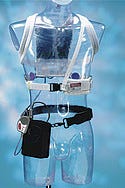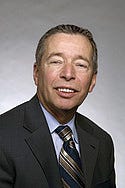Zoll Medical: Breathing New Life into Resuscitation
Zoll Medical has thrived thanks to innovative devices in the resuscitation area.
November 1, 2009
OUTSTANDING OEM
|
The LifeVest has electrodes that automatically gel when the device is ready to deliver a shock. |
Making automated external defibrillators (AEDs) may be difficult, but an even bigger challenge is gaining market share when competing with the likes of Philips and Medtronic. A company like Zoll Medical (Chelmsford, MA) has to come up with AEDs, as well as other products, that set the bar even higher.
“The professional marketplace for defibrillators—hospitals and EMS operations—is fully penetrated, so there are limits to the growth in that market,” says Ward Hamilton, Zoll's senior vice president. “It makes [us] look at other opportunities.”
For example, what if CPR could be administered automatically? What if AEDs were truly automatic and required no manual operation to deliver a shock?
Tasked with developing devices that are better than the market's current offerings, Zoll came up with the LifeVest. The device, designed for people at risk for sudden cardiac arrest, is the only wearable defibrillator on the market. According to Hamilton, Zoll invested in the technology behind it more than 12 years ago. For a public company with shareholders eager to see returns, “that's a long haul,” Hamilton says. Only now has the device come to a point where it's starting to become a standard of care. The company recently announced that the LifeVest was recommended by all 50 of the U.S. News and World Report's “best heart and heart surgery” hospitals.
|
Ward Hamilton, senior vice president at Zoll Medical, says that resuscitation technology has been essential to the company's growth and overall business strategy. |
The LifeVest is about the size of a Walkman. It functions without any intervention from the wearer or other operators. Once the LifeVest senses a shockable rhythm, it sounds an alarm. (And in case there is a malfunction, an override switch enables the wearer to stop the device from delivering the shock.)
“Each day, the patient wears a reusable vest that has dry electrodes. The electrodes automatically gel when the device is ready to deliver a shock. It's kind of like they slime the patient. We call it ‘blue goo,'” Hamilton jokes.
Peaks and Valleys
The company enjoyed a 29% uptick in revenue in FY 2008—totaling about $400 million—owing in large part to robust sales of the LifeVest and another product, the AutoPulse. Both are part of Zoll's efforts to thrive in the area of resuscitation.
“On average in America, when someone [suffers a sudden cardiac event], the likelihood of surviving in most communities and hospitals is 5%. But in communities that have far more aggressive care and treatment, including CPR, AEDs, better quality of CPR, and better management of those patients when they get to the hospital, survival can be as high as 50%,” Hamilton says. “Resuscitation has been our focus for the last five years, [and it has] been essential to our growth and to our business strategy.”
The AutoPulse, a key player in this strategy, provides better circulatory support than manual CPR and negates the issue of fatigue. It provides automated CPR through a load-distributing band that is applied around the chest. It compresses the heart between the sternum and the backbone and also manipulates thoracic pressures at the same time. Hamilton says the whole blood flow mechanism “is very different from what you can get when you just press on the chest with your hands.”
With unique products and booming revenue, prospects looked pretty good for Zoll. At the end of FY 2008, the firm had no debt—not to mention the $71 million in cash and investments it had accumulated. Forbes put the company on its list of the 100 fastest-growing companies.
The company hit a speed bump in April when it issued a voluntary recall of one of its defibrillators, the AED Plus. There was a potential risk of battery failure, and the device's software may not have detected the failure.
“It's never a happy day when you have to go fix something,” says Hamilton about the recall. “We looked at the measures we had in place and we have changed and added to our design and our verification and validation activities.” Hamilton says that Zoll is also working with its vendors to improve the monitoring of process changes.
Self-Resuscitation
Although the economy has tempered Zoll's growth somewhat, the company has still made moves to better position itself in the market. For example, Zoll has increased production capacity at its facilities in Pittsburgh and Sunnyvale, CA. It has also concentrated more on areas with the biggest growth potential—namely wearable defibrillators and Zoll's data business, which focuses on electronic patient care records.
Zoll has captured additional revenue from intravascular temperature management, thanks to its acquisition of Alsius Corp., a deal that was completed in May. The U.S. Department of Defense also inked a contract with Zoll worth almost $30 million for use of its Airworthy CCT defibrillators.
Zoll will continue to market its external pacing devices and defibrillators and plans to explore ventilation technology. Only time will tell whether the company can create more automated technology—or blue goo—to improve patient outcomes.
Copyright ©2009 Medical Device & Diagnostic Industry
About the Author(s)
You May Also Like



.png?width=300&auto=webp&quality=80&disable=upscale)
